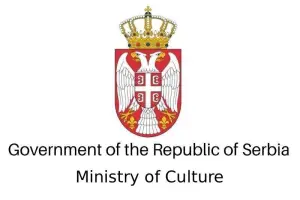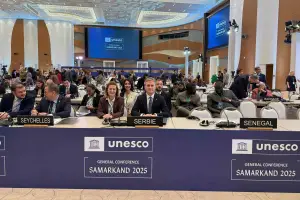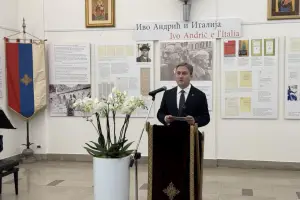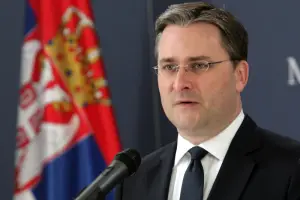- Serbia
Get to know Serbia
- Citizens
Culture and science
Health services
Pension and disability insurance
- Business
Employment
Economy
- Media
- Government
- Contact
Keep in touch
Contact form
Back
Keepin touch
Whether you have a question, comment, suggestion or any problem in the purview of the government, send us your message and we will try to respond as soon as possible. If your problem is not in our purview, we will forward your message to the relevant institution.
Q:
A:
“Serbia, A Land of Frescoes” exhibition in Vatican
Belgrade,
5 July 2011
Minister of Culture, Media and Information Society Predrag Markovic will open a “Serbia, A Land of Frescoes” exhibition at the Basilica of Saint Apostles in Vatican tomorrow.
The Ministry of Culture, Media and Information Society says in a statement that the Roman exhibits from the National Museum, sponsored by the Ministry, are a continuation of activities to promote the Serbian culture and cultural heritage abroad.
The exhibition aims to illustrate the artistic and spiritual aspect of the middle ages in Serbia and it represents a small anthology of the Serbian medieval artistic accomplishments, from Studenica monastery to the monastery of Kalenic.
Visitors will be able to see over 20 copies of frescoes, numerous casts in stone plastic and small-scale models of the monasteries of Sopocani and Mileseva.
The Italian audience, including hoards of tourists who visit Vatican every day, will have an opportunity to learn something about the specific visual expression of the Serbian medieval spirituality and culture.
Visitors will be presented with copies of the famous frescoes from the Church of Mother of Ljevis.
The Decani programme will be presented with a copy of the fresco of St. George, Gracanica – with portraits of King Milutin and Queen Simonida, Sopocani – with a fragment of the composition of the Nativity of Christ and the Church of St. Dimitrije – with the Nativity of the Blessed Virgin.
Ljubostinja, Mileseva and Sopocani monasteries, as well as Visoki Decani, will be presented with stone plastic models.
The exhibition “Serbia, A Land of Frescoes” was first showcased in 2007 in Strasbourg and then in Klagenfurt and Ljubljana.
In 2010 it was shown in Paris and Brussels, and this year in Florence, the statement adds.
The exhibition aims to illustrate the artistic and spiritual aspect of the middle ages in Serbia and it represents a small anthology of the Serbian medieval artistic accomplishments, from Studenica monastery to the monastery of Kalenic.
Visitors will be able to see over 20 copies of frescoes, numerous casts in stone plastic and small-scale models of the monasteries of Sopocani and Mileseva.
The Italian audience, including hoards of tourists who visit Vatican every day, will have an opportunity to learn something about the specific visual expression of the Serbian medieval spirituality and culture.
Visitors will be presented with copies of the famous frescoes from the Church of Mother of Ljevis.
The Decani programme will be presented with a copy of the fresco of St. George, Gracanica – with portraits of King Milutin and Queen Simonida, Sopocani – with a fragment of the composition of the Nativity of Christ and the Church of St. Dimitrije – with the Nativity of the Blessed Virgin.
Ljubostinja, Mileseva and Sopocani monasteries, as well as Visoki Decani, will be presented with stone plastic models.
The exhibition “Serbia, A Land of Frescoes” was first showcased in 2007 in Strasbourg and then in Klagenfurt and Ljubljana.
In 2010 it was shown in Paris and Brussels, and this year in Florence, the statement adds.
-
 Belgrade, 10 November 2025
Belgrade, 10 November 2025Initiative to ban photo exhibition “Serbian Woman” attack on historic memory
-
 Belgrade, 8 November 2025
Belgrade, 8 November 2025Croatia obliged to respond adequately to emergence of hatred, extremism against Serbs
-
 Belgrade/Cairo, 3 November 2025
Belgrade/Cairo, 3 November 2025Culture as foundation for enhancing overall relations between Serbia, Egypt
-
 Belgrade/Samarkand, 31 October 2025
Belgrade/Samarkand, 31 October 2025Serbia’s continued commitment to preservation of cultural heritage
-
 Požarevac, 24 October 2025
Požarevac, 24 October 2025Strengthening cooperation with Cyprus in field of cultural heritage protection
-
 Belgrade/Trieste, 18 October 2025
Belgrade/Trieste, 18 October 2025Exhibition on Ivo Andrić in Trieste new bridge of cultural cooperation with Italy
-
 Belgrade, 7 October 2025
Belgrade, 7 October 2025Condemnation of marking Serbian cultural heritage as Albanian
-
 Belgrade/Osaka, 5 October 2025
Belgrade/Osaka, 5 October 2025Virtual promotion of Serbian tradition, culture in Osaka
-
 Belgrade/Barcelona, 1 October 2025
Belgrade/Barcelona, 1 October 2025Cultural heritage as foundation of preserving national identity
-
 Belgrade/Barcelona, 29 September 2025
Belgrade/Barcelona, 29 September 2025Cultural cooperation between Serbia, Azerbaijan to further strengthen overall relations
